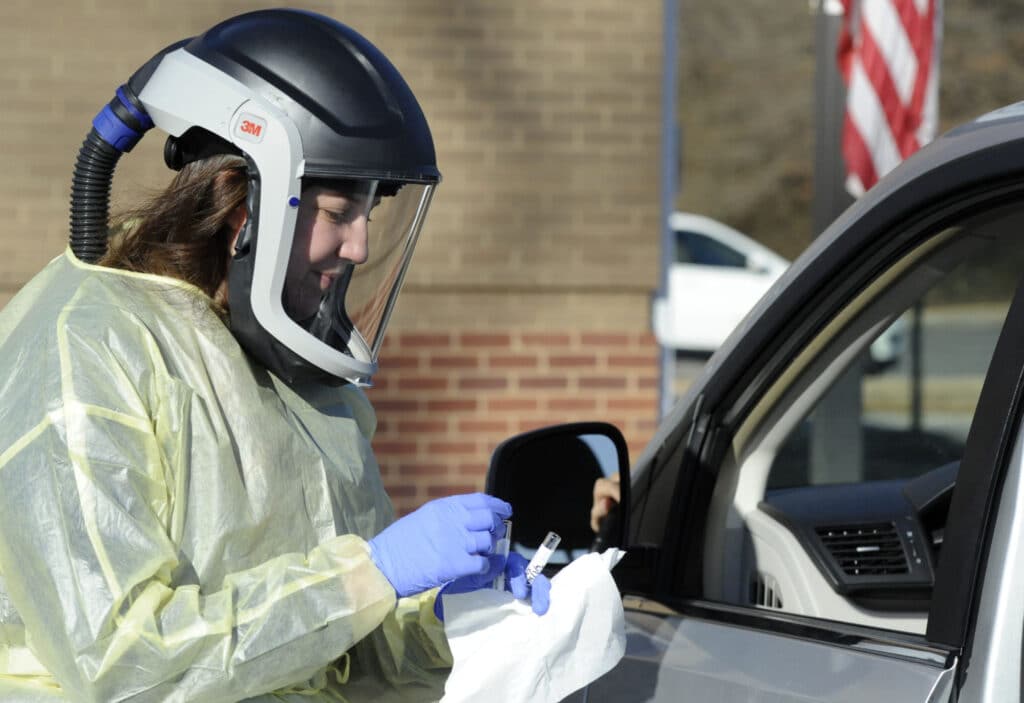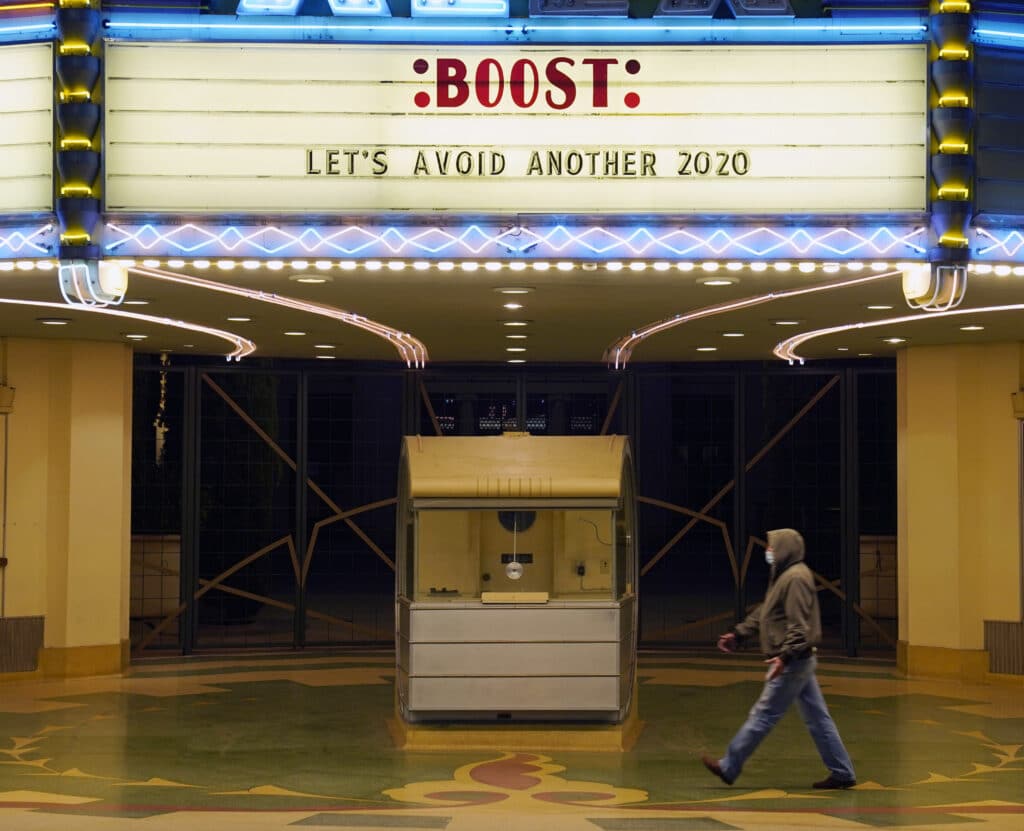As the omicron variant subsides, with 76% of the population vaccinated, demand has sharply dropped for the COVID-19 vaccine. Despite the decrease, those who have put vaccine mandates in place aren’t making any efforts to release them, which is why the People’s Convoy of truck drivers is headed to Washington D.C. to protest. The Associated Press has the story:
Americans tired of COVID-19 vaccines
HAMILTON, Ala. (AP) — A handwritten log kept by nurses tells the story of the losing battle to get more people vaccinated against COVID-19 in this corner of Alabama: Just 14 people showed up at the Marion County Health Department for their initial shot during the first six weeks of the year.
That was true even as hospitals in and around the county of roughly 30,000 people filled with virus patients and the death toll climbed. On many days, no one got a first shot at all, while a Mexican restaurant up the street, Los Amigos, was full of unmasked diners at lunchtime.
The vaccination drive in the U.S. is grinding to a halt, and demand has all but collapsed in places like this deeply conservative manufacturing town where many weren’t interested in the shots to begin with.

The average number of Americans getting their first shot is down to about 90,000 a day, the lowest point since the first few days of the U.S. vaccination campaign, in December 2020. And hopes of any substantial improvement in the immediate future have largely evaporated.
About 76% of the U.S. population has received at least one shot. Less than 65% of all Americans are fully vaccinated.
Vaccination incentive programs that gave away cash, sports tickets, beer and other prizes have largely gone away. Government and employer vaccine mandates have faced court challenges and may have gone as far as they ever will.
And with COVID-19 cases, hospitalizations and deaths subsiding across the U.S., people who are against getting vaccinated don’t see much reason to change their minds.
“People are just over it. They’re tired of it,” said Judy Smith, administrator for a 12-county public health district in northwestern Alabama.
The bottoming-out of demand for the first round of vaccinations is especially evident in conservative areas around the country.
On most days in Idaho, the number of people statewide getting their first shot rarely surpasses 500.
In Wyoming, a total of about 280 people statewide got their first shot in the past week, and the waiting area at the Cheyenne-Laramie County Health Department stood empty Tuesday morning. The head of the department fondly recalled just a few months ago, when the lobby was bustling on Friday afternoons after school with children getting their doses. But they aren’t showing up anymore either.
“People heard more stories about, well, the omicron’s not that bad,” Executive Director Kathy Emmons said. “I think a lot of people just kind of rolled the dice and decided, ‘Well, if it’s not that bad, I’m just going to kind of wait it out and see what happens.’”
Marion County, along the Mississippi line, is part of a band of Alabama counties where most people aren’t fully vaccinated more than a year after shots were rolled out. Just to the east, Winston County has the state’s lowest share of fully vaccinated residents, at 26%, according to the Centers for Disease Control and Prevention. About 42% are fully immunized in Marion County.
The digital sign outside First National Bank flashes Bible verses along with the temperature, and many Marion County residents work in small plants that make mobile homes and components for prefab housing. Most area jobs are blue-collar, and TVs are typically turned to Fox News. A conservative, working-class ethic runs deep.
The area went heavily for President Donald Trump in the 2020 election. And yet resistance to the vaccine is so strong that two counties over, in Cullman, some booed Trump when he encouraged vaccinations during a rally that drew thousands last summer.
COVID-19 has killed almost 18,000 people in Alabama, giving the state the nation’s fourth-highest rate of deaths relative to population. Marion County’s rate exceeds the state average at 1.78%, with more than 140 deaths, according to data from Johns Hopkins University.
Health officials expected to have a hard time persuading Black people to get government-sponsored vaccines in Alabama, home of the infamous Tuskegee syphilis study and a place where distrust of Washington runs deep. They started work on public education campaigns weeks early in mostly Black areas, which now have some of the state’s highest vaccination rates, at 60% or more.
But they didn’t expect the stiff resistance among rural whites that has kept vaccination numbers stubbornly low in places like Marion County, which is 94% white. While rural transportation difficulties, confusion over vaccine costs — they’re free — and a lack of health care access have also been factors, the partisan divide in America killed the vaccine drive for some before it really got started, officials said.
“Rural white men who identify as conservative are just not interested in this. That caught us off guard,” said Dr. Scott Harris, head of the Alabama Department of Public Health. “By the first or second month of the vaccine campaign, it became clear that those folks just weren’t going to come in.”
Richard Kitchens is among that group. The owner of a clothing and sports shoe shop on the square in Hamilton, Kitchens said he isn’t interested in the vaccine after getting COVID-19 in 2020 before vaccines were available and having relatives who contracted the illness, developed only minor symptoms and recovered.
Short of a proven guarantee against illness — which no vaccine provides — he doesn’t see the point.
“I guess if I knew I could go out and get a shot and wouldn’t get it or spread it, I would go get it, and they say it helps,” Kitchens said. “But I think that will be determined sometime down the road maybe.”
Doris Peterson is fully vaccinated, but she said she didn’t get a booster on the advice of her two adult daughters, neither of whom is vaccinated. Peterson said she is used to being one of the few people around still wearing a mask in public.
“Most of the time I am it,” she said.
Kelly Moore, a former Tennessee health official who now heads a CDC-funded vaccination advocacy organization named Immunize.org, recalled seeing data from a recent survey that hit her like a punch to the gut.
The results were presented at a CDC meeting of vaccine experts earlier this month. The January survey of about 1,000 adults asked unvaccinated participants what, if anything, would change their mind and persuade them to get a shot. Half said “nothing.”
“It was quite demoralizing to see those results, frankly,” Moore said.
With the pandemic still a mortal threat, public health workers haven’t given up on getting more people vaccinated, even if it feels like an uphill slog.
Jordan Ledbetter, a nurse who works at the Marion County Health Department, was thrilled when two people came in for first-time shots on the same day recently.
“That was exciting,” she said. “There are days when I haven’t given any vaccines.”
By JAY REEVES and MIKE STOBBE
Associated Press Writer Mead Gruver contributed to this report from Cheyenne, Wyoming.







